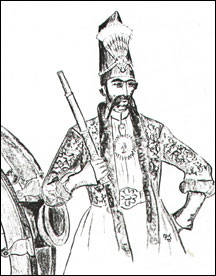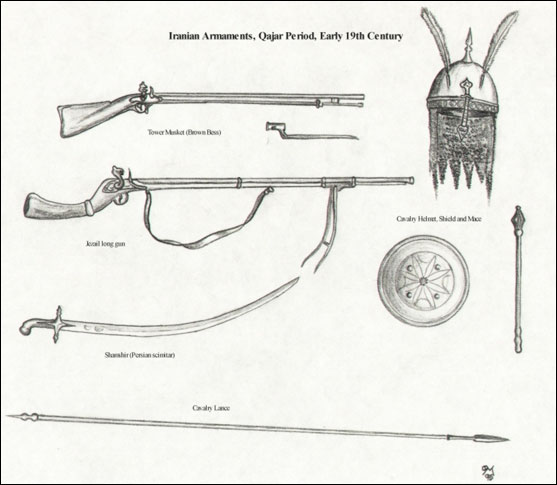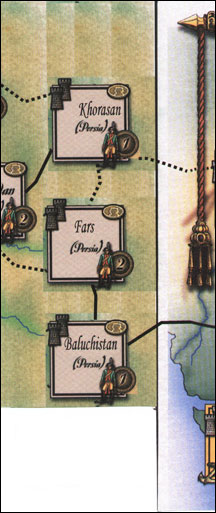| Iran
in the Age of the Raj
By David Meyler
August 2012
Iran in the latter half of the 18th century
lived under the shadow of Nader Shah (and
in some respects still does to this day).
He was born Nader Qoli on October 22, 1688,
a member of Turkic Afshar tribe. He rose to
become a beg — lord or chieftain —
of the Afshars, as well as one of the empire’s
most skilled generals under the reign of the
last of the Safavid shahs.
| 
Nader Shah, by David Meyler.
|
In 1719, Mahmoud Ghilzai led an Afghan army
into Iran, and in 1722 deposed
the ruling Shah Sultan Husayn and had himself
made emperor. This was one of the lowest points
in the long history of Iran. His reign did
not last, however, and in 1725 Mahmoud was
assassinated by his own men, and a cousin,
Ashraf, was crowned, marrying a Safavid princess
in an attempt to give himself some legitimacy.
Nader Qoli Beg initially served with the
Afghans in a campaign against the Ozbegs,
but when Ashraf withheld his promised payment,
he joined a revolt in 1727 with 5,000 men,
in support of the Safavid heir, Tamasp II.
Nader defeated the Afghans and drove them
out of Khorasan. Ashraf attempted to flee,
after massacring 3,000 Persians in Isfahan,
but was hunted down and killed.
While Nader was busy in the east, Tamasp
II invaded Ottoman Turkey to build up a military
reputation for himself. By 1732, the shah
had managed to lose Armenia and Georgia to
the Turks. Nader was enraged and had the shah
deposed, and replaced by Tamasp’s infant
son, under the name Shah Abbas III. This clearly
showed who the real power was.
Immediately, Nader struck back at the Ottomans
and regained all the territory lost by Tamasp.
Abbas died, apparently of natural causes,
in 1736, and Nader, dropping all pretense,
had himself crowned shah.
In 1738, Nader Shah launched what is likely
his greatest military campaign. He invaded
Afghanistan through Kandahar and captured
Kabul and later Bukhara. Nader then hit Moghul
India, captured and sacked Delhi, and slaughtered
30,000 of its citizens. He returned to Iran
with much of the Moghul treasure horde, including
the famed Peacock Throne and the Koh-i Noor
diamond. Nader then, in 1743, resumed the
war against Turkey scoring more victories,
and picking up some territory at the expense
of the Russian Empire. He also built a fleet
in the Persian Gulf and conquered Oman.
Time of Troubles
Nader’s domestic policy was one of
increasing paranoia and cruelty. Tamasp II
and his two surviving sons were murdered in
1740. Nader had his own son blinded and executed
many Persian nobles out of largely imaginary
fears of insurrection. He also made a failed
attempt to make Sunni Islam the state religion,
alienating many of his Shia supporters. Finally,
in 1747, while on campaign in Kurdistan, a
group of his own officers attempted to assassinate
him at dawn. “Better we make breakfast
of him before he makes supper of us,”
was their credo. The 61-year-old shah, while
caught by surprise, managed to kill two of
his attackers before he was overcome and killed.
Sometimes called the Second Alexander, the
Napoleon of Iran or the last of the great
Asian conquerors, Nader had expanded Iran’s
boundaries to their greatest extent since
the Sassanids in early medieval times. But
it was not to last. Succeeded by Adil Shah,
his nephew, the new emperor promptly had all
of Nader’s sons and grandsons executed,
save one, the 14-year-old Rukh. Adil was soon
deposed by his brother, who was them deposed
and murdered by his own troops. Adil was also
eliminated at this time. Rukh was then made
shah, deposed and blinded, then reinstated,
deposed and reinstated once again.
In short, the empire fell into anarchy, with
each of the various provincial governors ruling
their own petty kingdoms. Only in the south
was the warlord Karim Khan, 1753-1779, able
to maintain a core territory, what is historically
termed the Zand dynasty.
Qajar Revival
Upon the death of Karim, Agha Mohammad Khan,
a leader of the Turkic Qajar tribe from Azerbaijan,
began an attempt to reunite the empire. At
the age of six Mohammad had been castrated
on the orders of Adil Shah to prevent him
from becoming a political rival – it
didn’t work and it did not prevent Mohammad
Khan from establishing a dynasty. He had been
held captive for 16 years in Shiraz but managed
to finally escape in 1779.
In a long series of campaigns, Mohammad Khan
overcame all his rivals. The last of Zand
dynasty, Lotf’Ali Khan, was defeated
in 1794. He established the new capital at
Tehran, then a small provincial town of 15,000.
In 1796 Agha Mohammad led a successful expedition
against the Christian Kingdom of Georgia,
which was then reincorporated into Iran (raising
Russian ire). He conquered Khorasan, the last
centre of resistance to his authority; there
the ruler Shah Rukh (the blind, non-dancing grandson of
Nader Shah) was tortured to death. Mohammad
Khan was formally crowned shah in 1796, but
he did not long enjoy his hard won victory.
The following year, he was assassinated and
was succeeded by his nephew Fath Ali Shah.

Iranian weapons by David Meyler.
War with Russia
Fath Ali ruled to 1834 and finally reestablished
a degree of stability. With the aid of the
able Mirza Assadolah Khan, Minister of War
and the Crown Prince Abbas (or Abbas Mirza,
mirza means prince – that’s the
leader counter Abbas M. in Soldier Emperor),
a new army based on the Napoleonic model was
created. Pressure from Russia advancing into
the Caucasus led to the first Russo-Persian
War (1806-1813). The Russian forces generally
prevailed thanks to superior artillery. Still,
Abbas Mirza, using the terrain and superior
tactics, managed to win a number of victories
to stave off total defeat. The Treaty of Golestan,
however, confirmed the earlier Russian annexation
of the kingdom of Georgia, as well seeing
the loss of parts of the northern Caucasus.
The nation began to open itself up more to
European influence, and while Abbas Mirza
sent Iranians abroad to study European technology,
British advisors were brought into the country
to further reform the army (followed by the
French and Austrians in later decades). The
Ottomans were stunned by the performance of
the new Iranian army at the battle of Ezeroum
in 1821, which confirmed the existing boundaries
between the two empires.
Fath Ali Shah, however, then overstepped
himself, leading to the second Russo-Persian
War 1826-28. While the Iranian army under
Abbas Mirza had proved itself a dominant regional
force, it was still no match for a major power
like Russia, which was able to field a much
larger and better-equipped army. At the Treaty
of Turkomanchai, Iran ceded much of its northern
territories, the entire area north of the
Aras River (comprising present-day Armenia
and the Republic of Azerbaijan), and had to
pay Moscow a huge war indemnity.
The Great Game
Fath Ali died in 1834 and was succeeded by
his grandson Mohammad Shah. He attempted twice
without success to recapture Herat, an ancient
province of the Iranian empire, but long since
part of Afghanistan. Here, Iran was dangerously
getting drawn into the “Great Game.”
Mohammad Shah was pro-Russian, and while the
Afghan forces on their own were no match for
the Iranian army, the Afghans had British
backing (at least, while fighting the Persians).
Mohammad Shah died in 1848, with his son
Naser-ed-Din, taking the throne. He ruled
for most of the remainder of the century.
Iranian designs on Herat did not end, leading
to an all-out war with British India in 1856-57.
There was one battle of note, the Battle of
Khosab on February 8, 1856. The British won
a clear tactical victory using a large square
formation to beat off the Iranian cavalry.
But the fighting was not as one-sided as one
is led to believe from British sources, and
while the British had better firearms and
artillery, there were gross administrative
and supply deficiencies (as was also seen
in the Crimean War) that forced a British
retreat.
Still, the defeats against Russia and Britain
proved demoralizing, and Iran, while undergoing
something of a cultural revival under Qajar
rule, increasingly fell under the sphere of
influence of its two powerful neighbours.
In the political chaos following the assassination
of the aging shah in 1896, Iran became a virtual
colony of the Europeans, divided into a Russian
and a British sphere of interest. It would
not be until the 1920s, following the double
cataclysms of the First World War and Russian
Revolutions, before the country again gained
a measure of independence.
Variant: East Meets West
Soldier Raj and Soldier Emperor
already have provisions for linking their
maps. This variant adds an overland option
when playing linked scenarios.
 The
area missing between the two maps was not
great, so I made a small map overlay to add
eastern Persia. While not entirely to scale,
it serves as a link between the two maps.
The rules for inter-map movement remain unchanged,
but units can also now move overland (this
opens another option to intervene in Central
Asia, especially for Russia). The
area missing between the two maps was not
great, so I made a small map overlay to add
eastern Persia. While not entirely to scale,
it serves as a link between the two maps.
The rules for inter-map movement remain unchanged,
but units can also now move overland (this
opens another option to intervene in Central
Asia, especially for Russia).
Three new Persian land areas are added to
the Soldier Emperor map:
Khorasan (Fortifications 2, Money
1, Manpower 1), with a mountain route connecting
to Baku, a land route to Azerbaijan and mountain
route to Fars. Khorasan also connects to the
Soldier Raj map with a mountain route to Afghanistan.
Fars (Fortification 2, Money 1, Manpower
2), with a mountain connection to Azerbaijan,
a mountain connection to Khorasan and a land
route to Baluchistan.
Baluchistan (Fortification 2, Money
1, Manpower 1), with a land route to Fars.
Bauchistan also connects to the Soldier
Raj map with a land route to Baroda.
The map overlay joins the southeast portion
of the Soldier Emperor map with the
northwest frontier of Soldier Raj.
Persian forces remain unchanged.
Click here to
download the map!
Click
here to order Soldier Emperor! |
